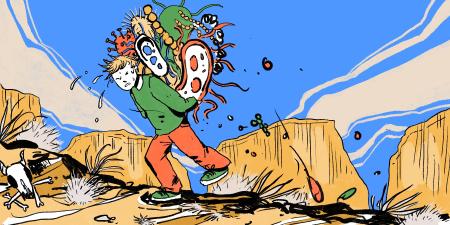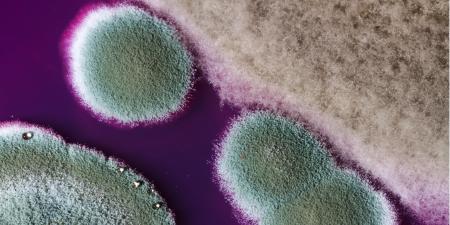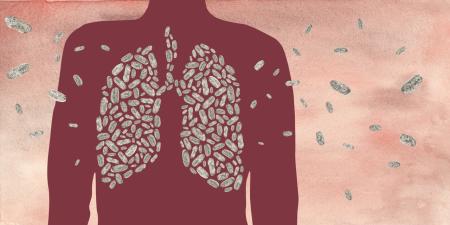Abstract
This essay plays out a few ethics reasons we have to reconsider what’s really being marketed to us in some free offers that distract us from questions of ethical, cultural, and clinical importance, for example. Possible points of focus for bioethics as a field are related to antimicrobial resistance and stewardship.
Will Work for Food
There’s a place in Lincoln Park in Chicago where I used to regularly see the same leucistic female Eastern gray squirrel—she was nearly all white except for the middle of her head—eating horse chestnuts. There are usually 2 to 4 chestnuts in each leathery, coarse, green capsule that falls from a tree. Most capsules are about the size of a tennis ball and the weight of a lacrosse ball. In late September or early October, a wise person won’t stand too long under a horse chestnut tree without a helmet. The capsules fall heavily, with a thud, and a hungry squirrel has to apply substantial force of jaw and paw to break the capsules, find the fruit, and finally eat.
Day after day, same squirrel, same place. She has to work hard for her food, I thought to myself when I watched her, I wonder why she doesn’t investigate that pile of easy free stuff over there. Within 20 minutes, she found the too-white heap of gluten I had spotted. She sniffed at what was nearly a whole loaf. She raised, lowered, then again raised her head. She was not tempted and resumed her struggles with the horse chestnuts strewn under broad crowns of 3 tall trees. You are discerning, squirrel, I observed and, inspired by the privileged heroine of Billy Joel’s famous song, named her Uptown Squirrel.
Litter and Masquerade
As I left the park, I walked past the pile of what Uptown Squirrel did not eat and what is commonly marketed to humans (for purchase) as bread. This litter confirmed my respect for the numerous posted alerts to not feed wild animals in the park.1 Nutritionally vacuous foodstuffs can, in some cases, help some wild animals consume enough calories to meet their energy demands, but they do not help them meet the profile of vitamins, proteins, and minerals they need for long-term well-being. Although micronutrient fortification improves some food items’ nutritional index, harms of feeding poor human foodstuffs to wild animals are well-known. One condition common among Canada geese and other wild birds attracted to human-littered, nutritionally poor food is called Angel Wing Syndrome,2 which is caused by malnutrition and is irreparable and eventually fatal because the birds’ improperly formed wings compromise their capacity for takeoff and flight.
A hard lesson of scarcity is that many animals have to eat what’s available in their environments, regardless of whether it meets their nutritional needs. Many humans, too, are pressed to eat poor-quality food when nutritionally dense food is scarce, too costly, or too hard to access. Under different conditions, any of us, including Uptown Squirrel, might eat that too-white heap. Conditions of scarcity are topics to which bioethics literature attends widely and well. What gets far less attention from bioethics, however, is why we are not more outraged by nutritionally poor food that is aggressively marketed to us. Shouldn’t we regard as deeply ethically problematic, for example, some cereal companies’ mockery of their corporate citizenship obligations (to not exploit children’s sweet teeth, for example) when colorful bits of cleverly spun sugar are masqueraded on supermarket shelves as food?
Food Products
Michael Pollan urges us to carefully distinguish between food and food products in our diets.3 So, let’s start with what I’m going to go out on a horse chestnut limb and call a clear case of a food product that does indeed make too-white gluten loaf look like a wonder.
Two months after last seeing Uptown Squirrel, I learned that humans were recently invited to order chicken feed . . . to eat. “Chix Mix, a snack inspired by antibiotics-free ingredients,”4 was a limited-time free promotion by one prominent agribusiness industrialist. I have not read a nutrition label for this product, but I’m guessing it contains vitamins and minerals this company selects for their chickens (not for you or me) to grow (preferably as fast as possible) to some saleable size and flavor profile.
Under different conditions, any of us, including Uptown Squirrel, might eat that too-white heap.
Also odd is that this product is vegetarian. In jest, I suppose this could be important to vegetarians who eat chicken. In earnestness, I suppose this could be important to people concerned about prions—even though that’s mainly a potential problem in poor cattle feed,5 not poultry feed. In any case, advertising forced vegetarianism of chickens or chicken feed seasoned for human consumption seems a strange marketing priority. Like many birds, wildfowl (eg, turkeys, prairie chickens, ducks, geese, swans) forage for items like grains, seeds, fruits, grasses, eggs, and insects; they have not evolved to be and are not, generally, vegetarians, at least not by choice. Perhaps we might at least take some comfort in that Chix Mix product “contains grains, primarily consisting of corn and soybeans and is mixed with vitamins, minerals and amino acids”4? Thankfully, fortification comes to our dietary aid in this product, just as it does in a pile of too-white gluten loaf.
Joke Time
C’mon, though, you might wonder: Humans eat many snack foods we joke about as junk food. Why single out Chix Mix for ethical scrutiny? OK, I’ll ease up. Even if the joke is on us, this product is, after all, a “seasoned blend” that the packaging invites us to regard as “chicken feed that’s good enough for humans.”4
Yes, you read that right: good enough.
Perhaps, like me, you are unsure whether this phrase is amusing, humiliating, or both. In any case, good enough should prompt us to recall habits of discernment expertly modeled by Uptown Squirrel. She would stop, sniff, paw, and maybe wonder, Are there antibiotics in this?
Darn good question, Uptown Squirrel! As it turns out, “Chix Mix is designed as a marketing opportunity as the industry faces controversy about antibiotics in chicken feed and treatment of its animals.”4 While it is grand to see an agribusiness industrialist nod to growing global public concern about problems such as concentrated agricultural feeding operation (CAFO) chickens’ welfare and antimicrobial resistance, it’s a vast logical leap from (a) eating a seasoned version of what their chickens eat to (b) mitigating threats to humanity posed by a rapidly growing list of pathogens resistant to the best available antimicrobial agents that once effectively stifled their growth, adaptation, and transmission.6 But, yes, this company would like you to order (for free!) and enjoy, as a token of this agribusiness industrialist’s antimicrobial stewardship, this package of yardbird mash’n’pellets.
C’mon, though, you might still wonder: Isn’t it good that agribusiness industrialists aren’t using antibiotics? There is a vast literature on antimicrobial uses in CAFOs that any reader can easily engage to further explore whether and when not using antimicrobials is good agribusiness practice. For purposes herein, however, an upshot is this: Chix Mix packaging specifies that antibiotics are not being used in the chicken feed; this tells us nothing about this company’s actual use, nonuse, overuse, or selective use of antimicrobials. Chix Mix packaging tells us nothing meaningful about this company’s antimicrobial stewardship practices.
Marketing for Distraction
Some have likely been beguiled by Chix Mix. So, let us recall how Uptown Squirrel, though momentarily distracted, realized that her time and precious physical energy were wasted on the free white litter and far better spent keeping to the business of wrestling horse chestnuts into edibility. We might follow her lead and resist being distracted by Chix Mix’s oddity, if not novelty, from the urgency and severity of antimicrobial resistance.
Strangely, the CNN story about Chix Mix I cite in this essay says that the US Department of Agriculture (USDA) and the World Health Organization (WHO) “allow for the use of antibiotics that are not crucial to the treatment of human diseases.”5 But we have good reasons to be suspicious of a claim that these agencies see agribusiness uses of antimicrobials as not undermining the effectiveness of these same antimicrobials’ applications in human health. In fact, neither the USDA nor the WHO view human animal and nonhuman animal pathogen vulnerability as so neatly, tidily, or clearly distinct.
Focus, Bioethics.
In fact, the USDA and WHO view agribusiness practices as clearly within the scope of things they find relevant and potentially threatening to human health. We’ve long been wary of zoonotic spillover and spillback threats,7 and we have good reasons to suspect that any proffered wall between microbes that affect nonhuman animals and microbes that affect human animals is illusory, or at least as permeable as a row of extra chairs that used to separate the smoking and nonsmoking sections of my favorite pizza place in the early 1990s. We know that “73% of all antimicrobials sold on Earth are used in animals raised for food [and that] … [a] growing body of evidence has linked this practice with the rise of antimicrobial-resistant infections, not just in animals but also in humans.”8 We also know that the WHO ranks “medically important antimicrobials for risk management of antimicrobial resistance due to non-human use” in its most recent (sixth) edition of Critically Important Antimicrobials for Human Medicine.9 Furthermore, the USDA National Institute of Food and Agriculture articulates as a goal of its antimicrobial resistance programs to “reduce or negate any potential negatively adverse impact of antimicrobials used in agriculture that may have potentially adverse effects on the treatment of human diseases.”10
One job of bioethics is, at least, to clarify federal and international agencies’ public policy stances when needed. Another job of bioethics should likely be to help draw out ethics and policy reasons to be suspicious of when and how good enough is offered to glibly joke about food product quality or drug effectiveness. We might also consider the moral psychological value of feeling insulted when agribusiness industrialists’ food products pose as antimicrobial stewardship tokens; specifically, we can channel our responses to such insults into resisting distraction generated by food products marketed with jocular tone about antimicrobial resistance or marketed as actual food.
Uptown Squirrel’s food selection behaviors might be taken as her wise suspicion that “free” is a currency of foolery. For humans, getting something for nothing can have momentary appeal as a gleeful surprise that satisfies our need, sometimes, for things to come easily to us. But “free” might be better viewed—at least in ethics terms—as a test of how cheaply one’s participation and complicity in the quiet-creeping harms of nonsense can be bought.
References
-
May C. The hidden harm in feeding your local wildlife: why feeding wild animals is harmful for them and us. US Fish and Wildlife Service. Accessed January 17, 2024. https://www.fws.gov/story/hidden-harm-feeding-your-local-wildlife#:~:text=Wild%20animals%20have%20naturally%20specialized%20diets.&text=Some%20may%20thrive%20best%20on,species%20it%20is%20designed%20for
-
Nature Museum. What is angel wing syndrome? Chicago Academy of Sciences. May 12, 2016. Accessed January 17, 2024. https://naturemuseum.org/2016/05/what-is-angel-wing-syndrome/#:~:text=If%20you've%20walked%20around,level%20of%20carbohydrates%20and%20sugars
-
Pollan M. In Defense of Food: An Eater’s Manifesto. Penguin Press; 2008.
-
Palinsky J. Perdue made chicken feed for humans to eat. CNN. Updated November 8, 2023. Accessed January 17, 2024. https://amp.cnn.com/cnn/2023/11/08/food/perdue-chix-mix-launch/index.html
-
Animal and Plant Health Inspection Service. Bovine spongiform encephalopathy. US Department of Agriculture. Updated May 30, 2023. Accessed January 18, 2024. https://www.aphis.usda.gov/aphis/ourfocus/animalhealth/nvap/NVAP-Reference-Guide/Control-and-Eradication/Bovine-Spongiform-Encephalopathy
-
WHO publishes list of bacteria for which new antibiotics are urgently needed. News release. World Health Organization; February 27, 2017. Accessed January 17, 2024. https://www.who.int/news/item/27-02-2017-who-publishes-list-of-bacteria-for-which-new-antibiotics-are-urgently-needed
-
One Health. Centers for Disease Control and Prevention. Reviewed December 1, 2023. Accessed January 17, 2024. https://www.cdc.gov/onehealth/index.html
-
Van Boeckel TP, Pires J, Silvester R, et al. Global trends in antimicrobial resistance in animals in low- and middle-income countries. Science. 2019;365(6459):eaaw1944.
-
WHO Advisory Group on Integrated Surveillance of Antimicrobial Resistance. Critically Important Antimicrobials for Human Medicine. 6th ed. World Health Organization; 2019. Accessed January 17, 2024. https://iris.who.int/bitstream/handle/10665/312266/9789241515528-eng.pdf?sequence=1
-
National Institute of Food and Agriculture. Antimicrobial resistance. US Department of Agriculture. Accessed January 23, 2024. https://www.nifa.usda.gov/grants/programs/food-safety/antimicrobial-resistance



